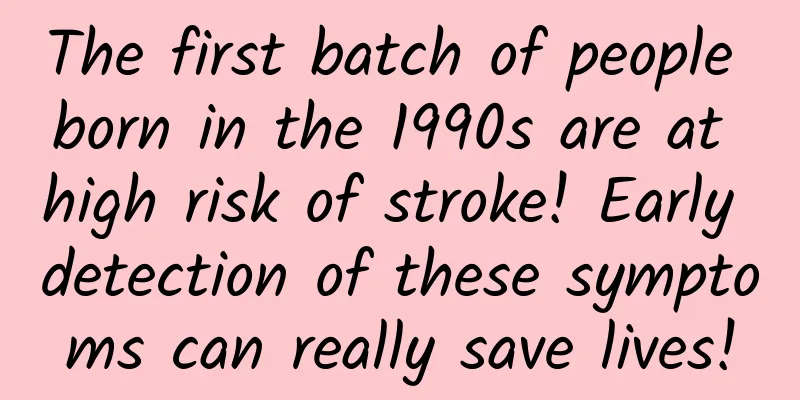The first batch of people born in the 1990s are at high risk of stroke! Early detection of these symptoms can really save lives!

|
Stroke or cerebral infarction is a sudden neurological disease. This disease, which has long been considered a health hazard for the middle-aged and elderly, has now quietly spread to young people. As young people such as those born in the 1990s are increasingly discussing the topic of stroke on social media, it is necessary for us to conduct an in-depth discussion on this phenomenon. So how many dots does this young group mark on the stroke map? The data reveals an unpleasant trend. In the United States, the incidence of stroke among adults aged 20 to 44 has increased significantly in less than two decades: from 17 cases per 100,000 people in 1993 to 28 cases in 2015. The hospitalization rate for ischemic stroke among people aged 18 to 44 doubled between 2003 and 2012. Looking at Europe, the incidence of ischemic stroke among young people under 55 also jumped, from 10.7 cases per 100,000 people in 1994-2002 to 18.1 cases in 2003-2011. In China, the situation is not optimistic either, with the prevalence of stroke doubling from 0.8% in 2000-2005 to 1.5% in 2012-2017. More importantly, the average age of stroke patients in China is about 65 years old, compared with 75 years old in developed countries. Today, let’s talk about stroke and explore how to prevent it at a young age, because stroke is no longer exclusive to the elderly, it is quietly changing the health map of young people. What is a stroke? To understand stroke in depth, we first need to know that it mainly comes in two forms: ischemic stroke and hemorrhagic stroke. Ischemic stroke is like a "myocardial infarction" in the brain. Imagine that a blood vessel in the brain is blocked by a blood clot, just like a city's water supply pipeline is suddenly blocked, and residents in that area will face a water crisis. For the brain, blood carries oxygen and nutrients. Once the supply is interrupted, the brain cells that rely on them for survival will be damaged or even die. Image source: pexels A hemorrhagic stroke is a flood in the brain. If a blood vessel in the brain bursts, blood can overflow into the brain tissue, depriving other areas of blood supply and damaging brain cells due to the increased pressure. Imagine if a pipe bursts in your home. Not only does the water not reach its intended destination, but it can also damage the structure and furniture of your home. When a stroke occurs, its destructive power is not limited to the brain. Since the brain is the command center of the body, controlling our movement, sensation, and cognitive functions, the effects of a stroke can be widespread. Some people may experience weakness or complete loss of movement, while others may lose the ability to speak or understand language, which is called aphasia. Others may have vision problems, and they may not see clearly or completely on one side of their field of vision. The effects of a stroke are far-reaching and varied, depending on the function of the damaged part of the brain and the extent of the damage. For some people, these effects are temporary and they can gradually recover with rehabilitation. For others, a stroke can cause long-term or permanent changes that affect their quality of life and independence. Therefore, it is important to understand stroke and realize that it is not just a problem for the elderly, but for people of all ages. Through education and prevention, we can better protect our brains and reduce the risk of stroke. What bad habits Could it make some young people more susceptible to stroke? Research has found that the most common risk factors for young people are high blood pressure, diabetes, high blood lipids, alcoholism, and smoking, all of which are closely related to our lifestyle habits. Lifestyle choices are like small decisions made every day, which converge into a river of life and health. Unbalanced diet, sedentary life, continuous overtime work, and the frequently neglected adequate sleep - these may be the silent approach of stroke. Like an hourglass of time, every unhealthy habit is constantly accumulating potential risks. Image source: pexels Then, there are the social and psychological factors hidden behind the fast-paced life: unspeakable pressure, lingering anxiety, depression in the haze. They are like invisible burdens, oppressing the fragile hearts of young people and indirectly affecting the health of cerebrovascular vessels. Finally, we have to talk about genetics and family history, which are the life codes we cannot choose. They also affect the risk of stroke in places unknown to us. Therefore, in order to reduce the risk of stroke, we need to start from the little things in life, eat a balanced diet, eat less oil and salt, quit smoking and drinking, and control basic diseases, such as blood pressure, blood sugar, and blood lipids; and do regular screening. How to tell if you are having a stroke? In a sudden crisis like stroke, every minute and every second is crucial. Knowing how to identify the signs of stroke is like mastering the code to save lives. We can quickly identify the signs of stroke with a simple "BEFAST formula". "B" - Balance refers to balance, loss of balance or coordination, sudden difficulty walking, and unstable gait; "E" - Eyes refers to the eyes, sudden changes in vision, difficulty seeing; "F" - Face refers to the face, which is asymmetrical and has crooked corners of the mouth; "A" - Arms refers to sudden weakness or numbness in the arms, usually on one side of the body; "S" - Speech refers to language, speaking unclearly and being unable to understand others' language; "T" - Time refers to time. The above symptoms indicate a possible stroke. Please do not wait for the symptoms to disappear on their own. Call 120 immediately for medical assistance. In addition to the "BEFAST formula", there are other symptoms that deserve our attention: for example, the sudden, unbearable severe headache may be a signal of a ruptured blood vessel in the brain. Knowing these symptoms is like holding a key to unveiling the mystery of stroke. They remind us that when the warning signs of stroke appear, we don't have to panic, but we must act quickly. Because in this race against time, the speed of understanding and reaction is the key to saving lives. Although the burden of stroke is still mainly on the shoulders of middle-aged and elderly people, the pace of life and habits of young people are quietly handing them an invitation to risk. Minor adjustments to lifestyle, such as a balanced diet, moderate exercise, adequate sleep, and avoiding excessive mental stress, these seemingly ordinary daily choices are the solid cornerstone of building a line of defense against stroke. Therefore, stroke prevention should be something that everyone should pay attention to. References [1]YahyaT,JilaniMH,KhanSU,etal.Strokeinyoungadults:Currenttrends,opportunitiesforpreventionandpathwaysforward.AmJPrevCardiol.2020;3:100085. [2]LiuJ,ShiZ,BaiR,etal.Temporal,geographicalanddemographictrendsofstrokeprevalenceinChina:asystematicreviewandmeta-analysis. AnnTranslMed.2020;8(21):1432. [3]WuS,WuB,LiuM,etal.StrokeinChina:advancesandchallengesinepidemiology,prevention,andmanagement.LancetNeurol.2019;18(4):394-405. [4]AslamA,KhanU,NiaziF,etal.Etiologyandriskfactorsofstrokeinyoungadults:Amulticentricstudy.AnnMedSurg(Lond).2022;82:104647. [5]TangM,HanG,YaoM,etal.RiskFactorsofIschemicStrokeinYoungAdults:AChineseSingle-CenterStudy.FrontNeurol.2022;13:874770. [6] Wu Author: Jiang Yongyuan, Internal Medicine Doctor Reviewer: Tang Qin, Director and Researcher of the Science Popularization Department of the Chinese Medical Association |
<<: Family members, heating up fruits in winter is really amazing!
>>: What should I do if I find a thyroid nodule?
Recommend
The best time to have sex after abortion
Abortion is a common method of terminating pregna...
What to do if breast obstruction leads to insufficient milk?
Breastfeeding is the best for newborns. Breast mi...
What causes hip pain in women?
Many women are very tired and may suffer from low...
What type of guys do girls who work in banks like? Are girls who work in banks easy to pursue?
Girls working in banks have pretty good job benef...
As flu season arrives, here’s what parents need to know…
Flu, learn about it! Influenza (flu for short) is...
Can pregnant women eat hamburgers?
Hamburgers are a type of Western fast food. Peopl...
How many days of pregnancy do you usually start to feel sleepy?
Many pregnant women find that during pregnancy, d...
What are the drugs that increase estrogen?
As we all know, estrogen is a growth hormone meta...
What are the functions and effects of hair care essential oils? How to use hair care essential oils
Hair care essential oil also has a good hair care...
What are the symptoms of premature uterine aging?
As people's pace of life accelerates, both me...
What causes women to have back pain when sleeping at night?
Many women always feel back pain when they sleep ...
Eleven tips to easily eliminate breast swelling
What should you do if you have breast pain, feel ...
What are the treatment and prevention drugs for children infected with respiratory syncytial virus?
In autumn and winter, respiratory viruses are pre...
Are there any tips for treating blackheads?
The problem of blackheads on the facial skin is p...
A little blood after sex
In life, I believe that many of my friends have e...









